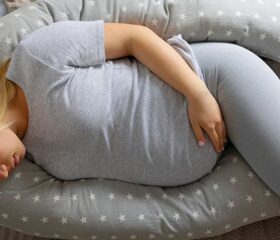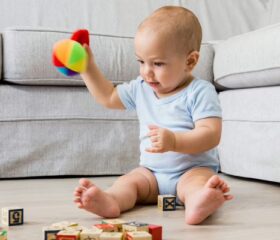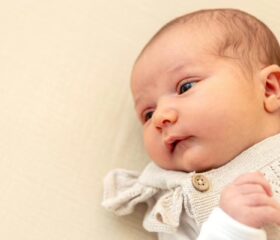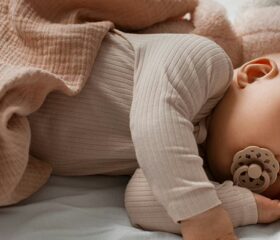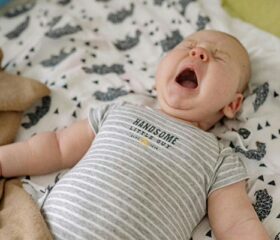When Can Your Baby Safely Sleep With a Pillow?
As a devoted servant to your adorable little dictator, you’ll want to do all you can to keep your baby comfy and cozy while he sleeps. But if you’re thinking of adding a pillow to your baby’s crib, you might want to think again.
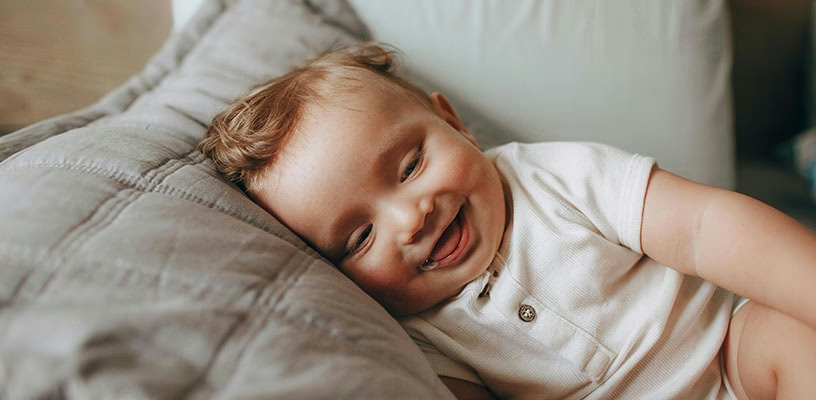
While adding a pillow to your baby’s sleep space might seem harmless, introducing one too early can be risky.
When, exactly, is the time right to let your child sleep with a pillow? Let’s walk through the recommended timelines, safety considerations, and tips for picking out the right pillow for your little one.
Why can’t young babies sleep with pillows?
According to the American Academy of Pediatrics (AAP), you should avoid using pillows, along with other soft items like blankets, crib bumpers, and stuffed animals, until your baby is at least 12 months old. A flat, firm sleeping surface is the safest option for babies and young toddlers.
The biggest reason to avoid pillows is to reduce the risk of sudden infant death syndrome (SIDS). 1 This alarmingly named syndrome is exactly what it sounds like—when a healthy baby suddenly and inexplicably dies during sleep.
It’s unclear what causes SIDS, which makes it scary for both new and seasoned parents. However, keeping a safe sleeping environment is the best way to reduce this risk, and there’s some evidence that pillow use may contribute to cases of SIDS.
Specifically, the health risks of letting your newborn sleep with a pillow may include:
- Suffocation risk: Soft pillows can block your baby’s airway if his face presses against the surface. 2 The same goes for any other soft items. Until your child’s first birthday, cribs should remain free of all soft bedding, including pillows, blankets, and stuffed toys. 3
- Overheating: Pillows can trap heat and increase the risk of your baby overheating. 3
- Climbing hazard: A pillow in the crib could act as a step if your toddler tries to climb out, leading to falls and injuries. 2
When is it okay to introduce a pillow?
Again, the AAP guidelines recommend no pillows before 12 months, but there is limited scientific research pinpointing the exact “safe” age to sleep with one. 4 This can muddy the waters if you’re wondering when you can stop worrying about SIDS.
You can base your child’s readiness on developmental milestones, such as:
- Having good motor control: By age 2, most toddlers have better motor control, making it safer to use a pillow without the risk of suffocation. 5
- Transitioning to a toddler bed: Many parents wait to introduce a pillow during the transition from a crib to a toddler bed, typically between 15 months and 3.5 years. 6
- Showing signs of readiness: If your toddler shows interest in a pillow, can move it away from his face, and is able to sleep comfortably without it becoming a distraction, he may be ready to use one.
When to introduce a pillow is always a personal decision. Most toddlers are perfectly comfortable sleeping without a pillow. There’s no need to rush this milestone, and it’s completely fine if your child doesn’t take to a pillow immediately.
Some parents are eager to introduce pillows a little early to prevent (or treat) flat spots on their babies’ heads. If you’re interested in doing that—or if you’re otherwise unsure what to do or just want to start earlier than 2 years—be sure to talk to your pediatrician before taking the plunge.
How to choose the right pillow for your toddler
If you’ve decided it’s time for a pillow, choosing the right one is key for your toddler’s safety and comfort. Here’s what to look for:
- Toddler-specific pillows: Look for pillows designed for toddlers. These pillows are typically smaller and thinner to provide proper support. 6 They’re also firmer, which reduces the risk of suffocation.
- The right materials: Opt for pillows made from hypoallergenic materials. 7 Cotton is always a good choice, since it’s cool and breathable, which is especially nice if your child tends to get warm at night.
- Fiber fillings: Fiber-filled pillows are a good choice for toddlers. Avoid pillows filled with microbeads, seeds, or grains, as these can pose choking hazards if the pillow tears.
- Organic and non-toxic options: Parents concerned about chemicals or allergens can consider organic pillows made with non-toxic materials.
Avoid adult-sized pillows, which are often too large and thick for toddlers and can strain their necks.
How to safely introduce a pillow to your toddler
Introducing a pillow doesn’t have jarring for your little one. Here are some ways to make the transition easier:
Make it familiar
Let your child get used to the pillow outside of sleep time. Use it during story time or quiet play so he’s more comfortable with it. You can even let him pick a fun pillowcase featuring his favorite character or pattern. This step may make him excited about sleeping with a pillow (and a little less resistant to bedtime).
Watch over your toddler carefully
Keep an eye on your toddler’s sleep patterns when using a pillow. If it seems to cause him discomfort or disrupt his sleep, remove it and try again later.
If your child starts using the pillow to climb out of the crib or does anything that seems unsafe, take it away right away. This is a sign he’s not ready for a pillow quite yet.
Don’t force it
If your toddler resists using a pillow, it’s best not to force it. Some toddlers just prefer to sleep without one—that’s completely normal. As long as he’s comfortable, safe, and getting enough sleep, that’s all that matters.
Final thoughts
Before you go out and buy your toddler his pillow, think about whether he’s ready. Remember, there’s no rush—he’ll transition to a pillow when the time is right.
If it’s time for him to hit this toddlerhood milestone, review your knowledge of healthy sleep habits for young children. You should:
- Always place your child flat on his back to sleep
- Use a firm, flat mattress with a fitted sheet
- Keep the sleep space free of other pillows, blankets, and stuffed toys
Follow those safety guidelines and choose a toddler-appropriate pillow that’s comfortable, gives your child adequate support, and is, above all, safe.
Article Sources
- American Academy of Pediatrics. "Safe and sound: Help young children get a good night's rest" Retrieved September 3, 2025.
- Safe to Sleep. "Ways to Reduce Baby's Risk" Retrieved September 3, 2025.
- Safe to Sleep. "Safe Sleep Environment for Baby" Retrieved September 3, 2025.
- Children (Basel). "Handle with Care: A Narrative Review of Infant Safe Sleep Practices across Clinical Guidelines and Social Media to Reduce SIDS" Retrieved September 3, 2025.
- Safe to Sleep. "Safe Sleep for Your Baby" Retrieved September 3, 2025.
- University of Rochester Medical Center. "Moving Your Toddler from Crib to Bed" Retrieved September 3, 2025.
- University of Rochester Medical Center. "Your Child's Asthma: Staying Away from Triggers" Retrieved September 3, 2025.

